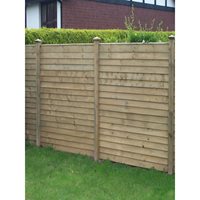Timber Fencing vs. Composite Fencing
When it comes to fencing your property, choosing the right material is crucial for both aesthetics and functionality. Two popular options that often come up in this decision-making process are
timber fencing and composite fencing. Each material brings its own set of benefits and considerations to the table. Let's explore the differences between timber and composite fencing to help you make an informed decision.
Timber Fencing: A Timeless Classic
Timber fencing has been a staple choice for property owners for generations, and for good reason. Here are some key points to consider:
1. Natural Beauty: Timber exudes warmth and character, blending seamlessly with outdoor environments. Its natural grains and textures add a touch of rustic charm to any property.
2. Customization: Timber fencing offers versatility in design, allowing for various styles and finishes to complement your property's aesthetic. Whether you prefer a traditional picket fence or a modern slatted design, timber can be customized to suit your taste.
3. Eco-Friendly: Timber is a renewable resource, making it an environmentally sustainable choice when sourced from responsibly managed forests. Additionally, timber fences are biodegradable and can be recycled at the end of their lifespan.
4. Maintenance: While timber fencing requires regular maintenance such as staining or sealing to protect against weathering, rot, and insect damage, some homeowners enjoy the opportunity for DIY projects or opt for low-maintenance timber varieties.
Composite Fencing: Modern Innovation with Practical Advantages
Composite fencing has gained popularity in recent years as a durable and low-maintenance alternative to traditional timber fencing. Here are some key considerations:
1. Durability: Composite fencing is engineered to withstand the elements, offering superior resistance to rot, decay, and insect damage compared to timber. Made from a blend of recycled plastics and wood fibers, composite materials provide strength and longevity.
2. Low Maintenance: One of the biggest advantages of composite fencing is its minimal maintenance requirements. Unlike timber, composite fencing does not require staining, sealing, or painting, saving homeowners time and effort in upkeep.
3. Consistent Appearance: Composite fencing boasts a uniform appearance with no knots or imperfections, providing a sleek and modern aesthetic. Additionally, composite materials are available in a range of colours and styles to suit any property design.
4. Initial Cost: While composite fencing may have a higher upfront cost compared to timber, its long-term durability and minimal maintenance can result in cost savings over time, making it a worthwhile investment for many homeowners.
Choosing the Right Fencing Material for Your Property
Ultimately, the decision between timber fencing and composite fencing depends on your priorities, budget, and preferences. If you value the natural beauty and customization options of timber and are willing to invest time in maintenance, timber fencing may be the perfect choice for you. On the other hand, if you prioritize durability, low maintenance, and long-term cost savings, composite fencing offers a modern and practical solution.
Before making your decision, consider factors such as your property's aesthetic, climate conditions, maintenance capabilities, and budget constraints. Consulting with JP Corry Staff or visiting your local
Outdoor Living Centres to see samples of both timber and composite materials can also help you visualize the options and make an informed choice.
Whether you opt for the timeless charm of timber or the modern innovation of composite, investing in quality fencing will enhance the beauty, security, and value of your property for years to come.
.jpg?lang=en-GB&width=200&height=200)
